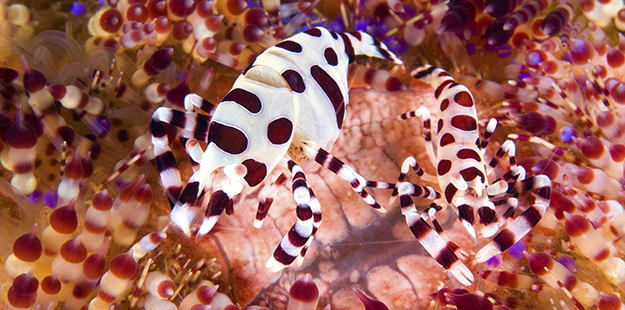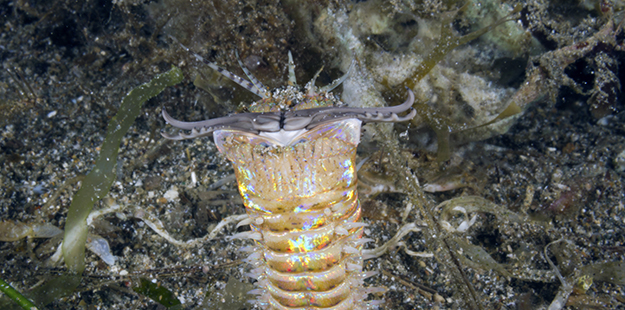Muck, Magic, and More
A Pelagian cruise showcases the full diversity of Indonesia’s underwater attractions
Wakatobi has earned a world-wide reputation for its pristine reefs, spectacular walls and diversity of marine life. But there’s another dimension to the region’s underwater landscape that many find equally appealing: muck diving. To the uninitiated, it might seem that a patch of unremarkable muddy bottom holds little of interest until you take a closer look. That’s when a cast of unique, ornate and bizarre characters are revealed. Some of these creatures can be found in the shallow near-shore areas of Wakatobi’s house Reef, but for serious muck enthusiasts, the best way to up the critter count is by signing on for a cruise aboard the dive yacht Pelagian.
Mucking around
Pelagian cruises begin at Wakatobi Dive Resort, and carry divers to a range of sites beyond the boundaries of the marine preserve. The itinerary often includes a visit to Pasarwajo Bay, on the southeastern coast of Buton Island. Here, the focus isn’t on reefs, but rather the near-shore shallows, where divers engage in underwater treasure hunts for the small and often highly cryptic critters that burrow into the seafloor silt, lurk in debris fields or hide among the supporting columns of village piers. A favorite site visited by the Pelagian is Cheeky Beach. Here divers are often shadowed from the surface by local children who show the cheeky enthusiasm that gave this site its nickname.

Cheeky Beach is a shrimp breeding ground for several of the more exotic species such as Coleman shrimp, which live exclusively on fire urchins and are often found in pairs. Photo by Walt Stearns
The beauty of Cheeky Beach, and for that matter most muck sites, is that it can be dived repetitively, rendering unique and different finds every time. The big news at Cheeky Beach is the small stuff, as it is a shrimp breeding ground for several of the more exotic species found in the Wakatobi region. Found here in abundance are class favorites like the Coleman shrimp. Often found in pairs (the larger is the female), these exquisite shrimp live exclusively on fire urchins, taking up residence in the middle of the urchin’s toxic spines. The host urchin’s spines do not harm the shrimp, but they usually clear an area on the urchin where they perch, making for a compelling macro subject.
“This was the best boat diving we ever experienced. Excellent service with the best muck dive of our lives!” Raija Pohjola and Karsten Boden
Also on the shrimp menu are several varieties of mantis shrimp, including the enigmatic peacock mantis, along with a host of smaller species that often require a bit of visual detective work to locate. Find a blue starfish and there’s a good chance there will be a few harlequin shrimp nipping away at it’s flanks, as starfish are this species favorite food. An closer look at a seemingly unimpressive find such as a sea cucumber may yield a pair of imperial shrimp; for a more colorful composition, photographers look for this same species attached to a colorful nudibranch such as a Spanish dancer. Divers with keen eyesight can scan algae-covered rocks in search of the tiny harry shrimp, or check among the spines of an urchin for a chance at locating the colorful bumblebee shrimp.

Like an alien life form from a scary Sci-fi movie, the Bobbit worm sits ready to snap its sharp jaws on an unsuspecting prey. Photo by Walt Stearns

When alarmed, or threatened, the blue-ringed octopus displays iridescent blue rings over the dorsal and lateral surfaces of its mantle, something most divers are thrilled to witness. Photo by Nigel Wade
The same soft substrate that shrimp prefer is also home to a number of animals that burrow into the bottom. Stake out a promising hole in the sea floor and you might witness the ambush attack of a bobbit worm, which lunges from cover to capture passing victims. Cuttlefish, blue-ringed and wonderpus octopus are all known to burrow for shelter, but can also be encountered out and about, especially in the evening or during night dives. One of the area’s most comical species of cephalopod doesn’t dig in, and instead takes up residence in discarded coconut shells. Should you see a coconut husk drifting or rolling across the bottom, take a second look, beaus there might be a coconut octopus inside. I recommend this trip for anyone who enjoys a mixture of reefs, walls and muck. I came for the muck diving and was not disappointed. An excellent dive yacht with a great crew! says Ron Lucas.


